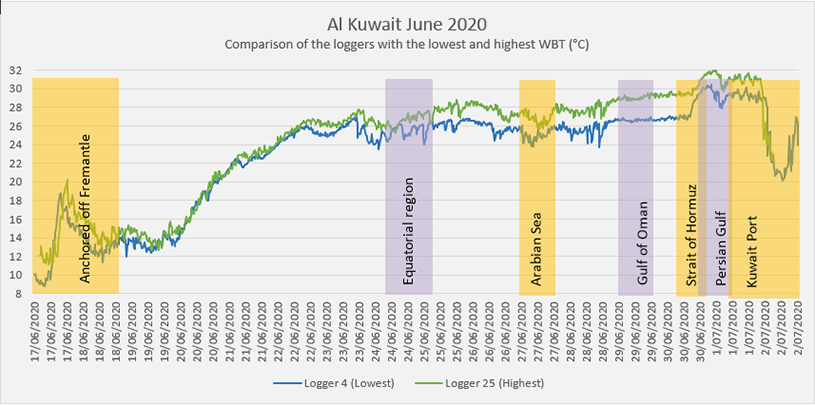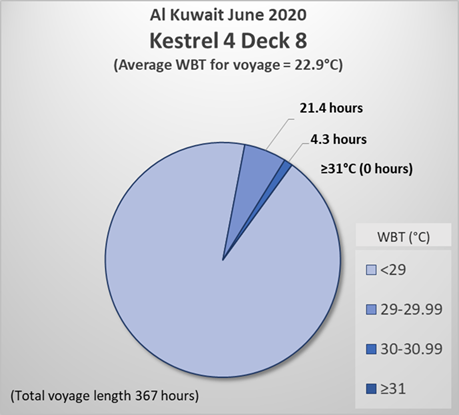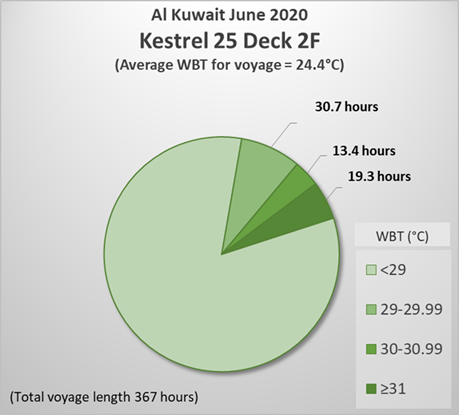Sheep exported to Kuwait in June 2020 - Report 219a, August 2020
Download
| Document | Pages | File size |
|---|---|---|
Additional voyage report on MV Al Kuwait - Sheep exported to Kuwait in June 2020 DOCX |
8 | 1.0 MB |
If you have difficulty accessing these files, visit web accessibility for assistance.
Online version
[expand all]
Introduction
The Al Kuwait, originally scheduled to depart Australia in late May with approximately 56,000 sheep, was unable to depart as planned following confirmed cases of COVID-19 among crew members.
On 27 May 2020, the exporter applied for an exemption to the Northern Summer Order. The decision not to grant an exemption was delivered on 2 June 2020.
On 8 June 2020, the exporter made a second application for an exemption. On 13 June 2020, the decision to grant an exemption from section 8 of the Northern Summer Order was made, subject to a number of conditions:
- the vessel used for the consignment was the Al Kuwait
- the loading ceased by 24:00 hrs on 17 June 2020
- there was only one port of discharge
- the vessel is stocked at a minimum allometric pen space allowance of 0.037
- no sheep are loaded onto an area of the deck on the ship identified as presenting a risk of higher deck WBTs
- the sheep types averaging above 50 kg are removed from the consignment
- sheep with wool of over 20 mm are removed from the consignment
- at least one additional stock person accompanies the voyage
- the export and related loading, voyage and discharge are otherwise undertaken in-line with the exemption application and the updated management plans.
To comply with the conditions, 23,000 sheep were removed from the consignment, resulting in 33,000 of the original 56,000 sheep being exported to Kuwait.
Monitoring of temperatures during the voyage
The department required the exporter to install environmental loggers (loggers) on the vessel for this voyage. The loggers recorded temperature and humidity data every 20 minutes for the duration of the voyage. The Al Kuwait had 30 loggers spread across every deck and its bridge. The exporter collected the data from the loggers and was required to provide this data to the department following completion of the voyage.
The most important environmental measure related to heat stress for this voyage was the wet bulb temperature (WBT). The WBT is the temperature read by a thermometer covered in a water-soaked cloth or by equivalent electronic devices (loggers), as was the case for this voyage.
The loggers on the Al Kuwait showed that WBT temperatures varied between locations on the ship. Figure 1 and Figure 2 compare the data from the loggers with the lowest (K4 on Deck 8) and highest (K25 on Deck 2F) average WBTs recorded throughout the voyage. The highest WBT recorded on the voyage was 32.0°C for a period of 1 hour 20 minutes.
Figure 1 Wet bulb temperature readings throughout the voyage

Note: Data originates from the loggers with the lowest (K4) and highest (K25) average temperature (°C) readings and includes the identification of important voyage locations.
Figure 2 Comparison total combined time spent at various WBTs


Note: Total combined time in hours spent from the logger with the lowest average temperature readings (left chart – K4) and highest average temperature readings (right chart – K25) from the voyage.
Table 1 Sheep heat stress score
| Heat Stress Score | 0 - Normal | 1 - Elevated | 2 - Heat affected | 3 - Onset of heat stress | 4 - Severe heat stress |
|---|---|---|---|---|---|
| Pant Score | 0 – Normal | 1 – Normal (elevated RR) | 2 – Mild panting | 3 – Open mouth panting | 4 – Open mouth panting with tongue out |
| Respiratory Character | Normal | Increased RR | Rapid RR | Laboured | Extremely laboured |
| Appearance or demeanour | Normal | Normal | Discomfort | Extreme discomfort | Distressed |
| Respiratory rate (RR) | 25-80 | 80-100 | 100-160 | 160-220 | Usually second stage |
Note: The heat stress score is a scoring system used to describe the heat affect physically observed upon sheep. The 5-point scale assesses sheep according to the character of respiration changes. Dissipation of heat occurs by panting, as sheep are incapable of sweating. Sheep do not always open their mouths when panting, and in the footage can be seen moving back and forward slightly (panting).
The observer was directed to collect video footage of sheep located adjacent to 20 of the temperature loggers at least once per day, and not at a prescribed time of day.
The video samples provided at key geographical locations during the voyage are of sheep in the vicinity of K4 and K25 data loggers (lowest and highest average WBT recorded throughout the voyage respectively). The videos were obtained as Australian Western Standard Time (AWST) and not local vessel time. These videos may not have necessarily coincided with the highest WBTs recorded on that day.
The observer estimated the percentage of sheep at each heat stress score (see Table 1) as the highest score observed that day.
Voyage overview
[expand all]
Loading
Loading commenced at 12:00 hrs on 16 June 2020, and was completed at 11:30 hrs, 17 June 2020.
Fremantle anchorage
The vessel remained anchored at Cockburn Sound for two days due to stormy weather. Lowest and highest WBTs were 8.8°C (at 05:20 hrs AWST) and 18.8°C (at 13:20 hrs AWST) for K4 and 11.1°C (at 04:20 hrs AWST) and 20.2°C (at 13:20 hrs AWST) for K25. Video taken by the observer was at 19:49 hrs AWST for K4. No video was taken of K25 at this time.
A daily report received from the observer commented that ‘sheep in some pens have been observed to be all resting at once in sternal recumbency on the pen floor and today they appeared generally slightly less flighty.’
Equatorial region
The vessel crossed the equator on day 8 of the voyage. Lowest and highest WBTs were 23.5°C (at 02:00 hrs AWST) and 26.1°C (at 23:20 hrs AWST) for K4 and 25.2°C (at 07:20 hrs AWST) and 27.7°C (at 23:00 hrs AWST) for K25. Videos taken by the observer were at 21:04 hrs AWST for K4 and 23:27 hrs AWST for K25.
The observer’s daily report noted ‘sheep on board are noticeably settled and more content in their pens and with shipboard routines’.
The highest heat stress scores (see Table 1) provided by the observer on this day were:
- No sheep at heat stress score 0
- 50% at heat stress score 1
- 47% at heat stress score 2
- 2% at heat stress score 3
- 0.5% at heat stress score 4.
Arabian Sea
The vessel entered the Arabian Sea on day 11 of the voyage. Lowest and highest WBTs were 23.7°C (at 06:00 hrs AWST) and 26.4°C (at 20:40 hrs AWST) for K4 (lowest) and 25.6°C (at 06:00 hrs AWST) and 28.4°C (at 16:20 hrs AWST) for K25 (highest). Videos taken by the observer were at 21:08 hrs AWST for K4 and 22:52 hrs AWST for K25.
On this day, the observer reported that the ‘sheep on board are settled and content in their pens and with the shipboard routines’.
The highest heat stress scores (see Table 1) provided by the observer on this day were:
- No sheep at heat stress score 0
- 75% at heat stress score 1
- 24% at heat stress score 2
- 1% at heat stress score 3
- No sheep at heat stress score 4.
Gulf of Oman
The vessel crossed the Gulf of Oman on days 12 to 13 of the voyage. Lowest and highest WBTs were 26.3°C (at 06:40 hrs AWST) and 27.0°C (at 16:00 hrs AWST) for K4 and 28.7°C (at 05:20 hrs AWST) and 29.5°C (at 20:00 hrs AWST) for K25. Videos taken by the observer were at 21:34 hrs AWST on day 13 for K4 and at 21:34 hrs AWST on day 12 for K25.
A report from the observer on this day reported that ‘sheep on board are settled but demonstrating increased respiratory efforts to remain within their individual comfort zones as temperatures and humidity has increased again today’.
The highest heat stress scores (see Table 1) provided by the observer on this day were:
- No sheep at heat stress score 0
- 12% at heat stress score 1
- 80% at heat stress score 2
- 6% at heat stress score 3
- 2% at heat stress score 4.
Strait of Hormuz
The vessel coursed the Strait of Hormuz on day 14 of the voyage and recorded the highest WBT of the voyage. Lowest and highest WBTs were 26.7°C (at 10:00 hrs AWST) and 30.4°C (at 21:40 hrs AWST) for K4 and 29.2°C (at 07:20 hrs AWST) and 31.9°C (at 20:00 hrs AWST) for K25. Videos taken by the observer were at 01:17 hrs AWST for K4 and 02:57 hrs AWST for K25.
The highest of these WBTs occurred during the night. By morning, the observer reported that ‘sheep on all decks earlier this morning were observed to be more comfortable than last night’. No heat stress scores were recorded overnight.
The highest heat stress scores (see Table 1) provided by the observer on this day were:
- No sheep at heat stress score 0
- 1% at heat stress score 1
- 84% at heat stress score 2
- 12% at heat stress score 3
- 3% at heat stress score 4.
Persian Gulf
The vessel travelled through the Persian Gulf on day 15 of the voyage. Lowest and highest WBTs were 27.9°C (at 5:20 hrs AWST) and 30.1°C (at 17:40 hrs AWST) for K4 and 29.7°C (at 05:20 hrs AWST) and 32.0°C (at 00:00 hrs AWST) for K25. Videos taken by the observer were at 03:59 hrs AWST for K4 and 01:58 hrs AWST for K25.
The observer commented that ‘sheep on all decks were observed to be more comfortable in a period of a few hours once humidity levels dropped and remained there’.
The highest heat stress scores (see Table 1) provided by the observer on this day were:
- No sheep at heat stress score 0
- 20% at heat stress score 1
- 70% at heat stress score 2
- 9% at heat stress score 3
- 1% at heat stress score 4.
Kuwait Port
The vessel arrived at Kuwait on day 16 of the voyage. Lowest and highest WBTs were 20.1°C (at 11:40 hrs AWST) and 29.7°C (at 00:00 hrs AWST) for K4 and 22.3°C (at 09:00 hrs AWST) and 25.0°C (07:00 hrs AWST) for K25. Videos taken by the observer were at 03:44 hrs AWST for K4 and 02:19 hrs AWST for K25.
Heat stress scores for this day are not available as the observer disembarked prior to completion of discharge. The observer later provided an update, stating ‘similar numbers were observed with increased heat stress scores before the drier air pushed through the deck areas allowing heat to be transferred much more efficiently from the sheep to the environment… sheep heat stress scores have reduced significantly due to local conditions as wet bulb and humidity dropped’.
Discharge
Discharge commenced at 02:20 hrs local time on Day 16. Discharge was paused and recommenced at intervals to avoid hotter periods of the day. The observer disembarked the vessel 7 hours prior to completion of discharge at Kuwait due to COVID-19 related travel limitations. The AAV and stockpersons remained until completion of discharge, with no issues identified in the End of Voyage Report provided by the AAV.
Conclusion
A total of 28 mortalities occurred on this voyage, or 0.084%. There were no deaths attributed to hot environmental conditions by the AAV.
Read the summary report of key observations reported by the observer on this voyage.
